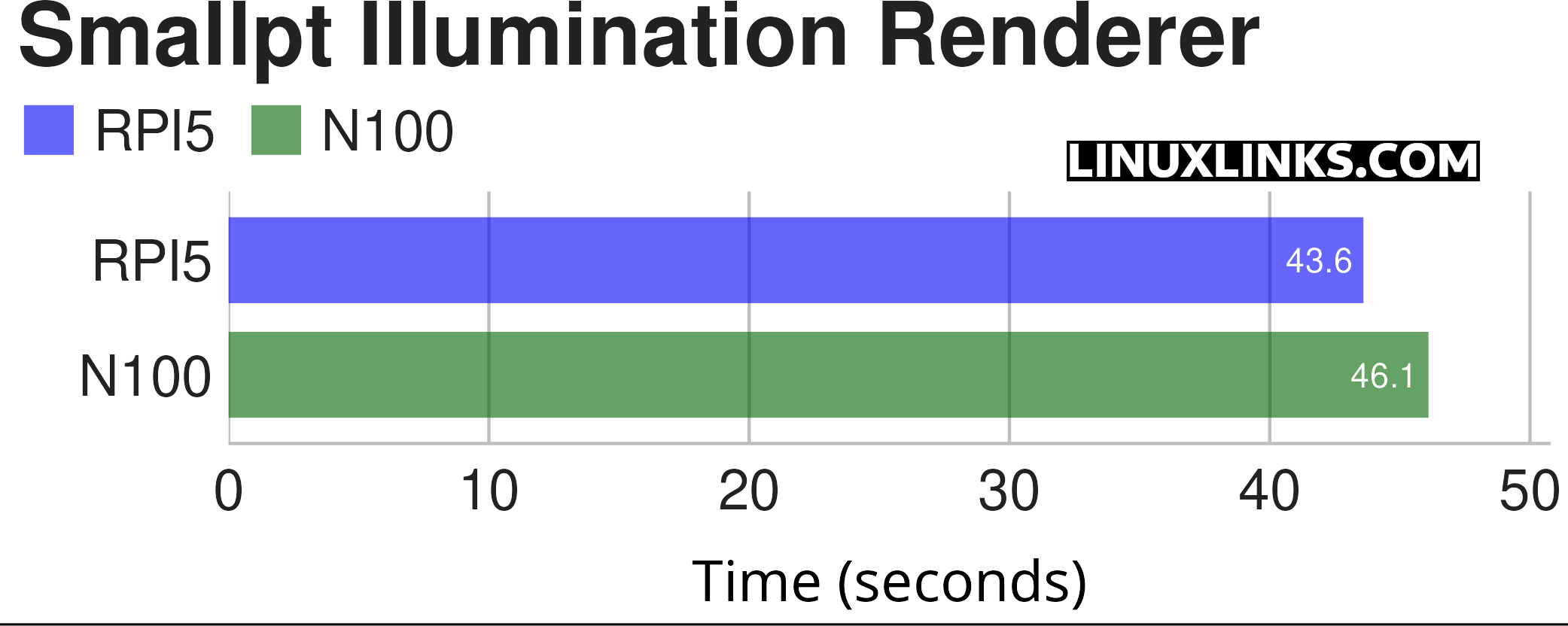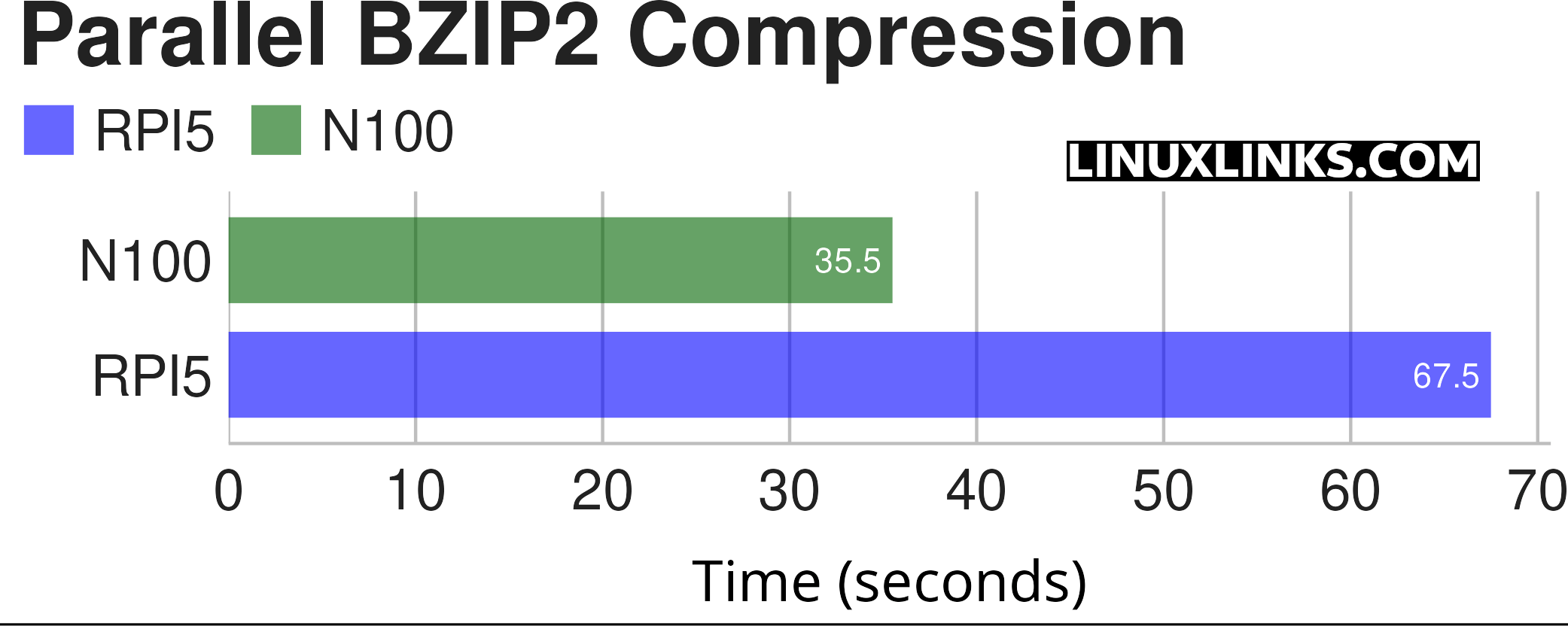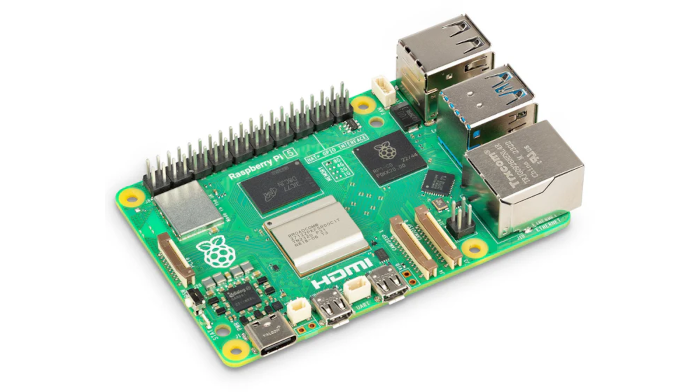This is a series of articles on the Raspberry Pi 5 focusing on using this single board computer as a desktop PC.
A question I get asked a fair bit is whether the Raspberry Pi 5 represents good value as a desktop PC. When considering value for money, we have to bear in mind use cases, performance and price (including ongoing costs). Let’s look at performance first.
Performance
As we saw in my benchmark article, the Raspberry Pi 5 is no slouch compared to an Intel N100. For example, the Pi 5 beat the N100 in the Smallpt illumination renderer benchmark.

In this benchmark, completing the test in a shorter time represents better performance.
However, on many benchmark tests, the Raspberry Pi 5 lags behind an N100 machine, in some cases by a long way e.g. the parallel BZIP2 compression benchmark.

Price
To use the Raspberry Pi 5 machine as a desktop machine with comparable specs to a bog standard N100/N150 mini PC, we need to kit out the Pi 5 with some storage, Raspberry Pi’s NVMe HAT, an RTC battery, a power adapter and a case. I’ll use a fanless case which uses passive cooling as this saves buying a fan or a more expensive case. It’s a fair comparison given many budget mini PCs are housed in a cheap plastic case.
| Raspberry Pi 5 as a desktop PC | |
|---|---|
| Pi 5 16GB | £114.90 |
| 512GB SSD * | £23 |
| Power Supply | £11.40 |
| M.2 HAT+ | £11.50 |
| Pi 5 Case | £5 |
| Pi 5 RTC Battery | £4.80 |
Total Cost | £170.60 |
| * Many budget Mini PCs use a disk with only 500-550 MB/s read/write speed even though they can take a faster NVMe. I've therefore priced a similar spec for the Raspberry Pi 5 | |
From a quick search on AliExpress, it’s easy to find a Mini PC with 16GB RAM and 512GB SSD for a lower price (particularly as they are often on sale) although they have risen in price since I purchased one for under £100.
Ongoing costs
Assuming you use the machine for 8 hours a day under light usage, the Pi 5 is about £6-£7 a year cheaper to run as it consumes fewer watts than a N100 Mini PC.
Summary
On the face of it, if you just want a cheap mini PC, the Raspberry Pi 5 doesn’t appear that competitive.
But if you’re planning to make small DIY projects using the GPIO pins, as well as using it as a mini PC the Pi 5 represents great value. And when you factor in low power consumption, huge community support, an actively maintained distribution with a guarantee that the Pi 5 will remain in production until at least January 2036, and a reliable brand, the Pi 5 looks very attractive.
This article was written on a Raspberry Pi 5 (16GB RAM) provided by SunFounder, a company focused on STEAM education with products like Open-source robots, Arduino & Raspberry Pi Kits, display screens, and other smart devices.
All articles in this series:
| Raspberry Pi 5 Series | |
|---|---|
Hardware | |
| iRasptek Starter Kit | All the kit you need to get started with the Pi 5 |
| Pironman 5 Case Review | Transform the Pi 5 into a beautiful desktop mini PC |
| Passive Cooling the Pi 5 | Passively cool your Pi 5 the right way. Silent yet cool |
| Benchmarking | Benchmarking the Pi 5 against an Intel N100 mini PC |
| Overclocking | Let's increase the clock speed of the BCM2712 SoC |
| Power Consumption | Compare the power consumption of the Pi 5 with Intel Mini PCs |
| 2.5Gbps Networking | Improving the wired performance of the Pi 5 |
| WiFi | Improve WiFi performance of the Pi 5 |
| Desktop PC | Is the Pi 5 good value compared to an Intel N100 Mini PC? |
Configuration | |
| raspi-config | Useful text-based tool to configure the Pi 5 |
| PiGro | GUI tool that streamlines the process of managing the Pi 5 |
| Increase Swap Memory Size | Increase the swap size from 512MB to 2GB |
| ZRAM swapdrive | Simple script to use a ZRAM swapdrive instead of a swapfile |
Software | |
| Installing Software | Different ways to install software on the Pi 5 |
| df snap pollution | Replace df with dysk |
| Ollama GUI | Running Large Language Models on the Pi 5 |
| Music Players | GUI and TUI music players explored |
| Internet Radio | Exploring the best options for both GUI and TUI software |
| Many software articles are planned. Stay tuned! | |
